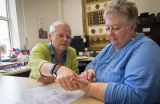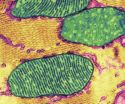(Press-News.org) BEIJING, CHINA (17 June 2014)—A dangerous strain of avian influenza, H7N9, that's causing severe illness and deaths in China may be inhabiting a small fraction of its potential range and appears at risk of spreading to other suitable areas of India, Bangladesh, Vietnam, Indonesia and the Philippines, according to a new study published today in the journal Nature Communications.
Researchers from the Université Libre de Bruxelles (ULB), the International Livestock Research Institute (ILRI), Oxford University, and the Chinese Center of Disease Control and Prevention analyzed new data showing the distribution and density of live poultry markets in China and of poultry production overall in the country. They found that the emergence and spread of the disease up until now is mainly linked to areas that have a high concentration of markets catering to a consumer preference for live birds and does not appear related to China's growing number of intensive commercial poultry operations.
They have pinpointed areas elsewhere in Asia with similar conditions (places with a high density of live bird markets) that could allow H7N9—which has infected 429 people thus far and killed at least 100—to significantly expand its range. Places at risk include urban areas in China where the disease has not yet occurred, along with large swaths of the Bengal regions of Bangladesh and India, the Mekong and Red River deltas in Vietnam, and isolated parts of Indonesia and the Philippines.
"We're not saying these are areas where we expect to see infections emerge, but the concentration of bird markets makes them very suitable for infection should the virus be introduced there, and that knowledge could help guide efforts to limit transmission," said Marius Gilbert, an expert in the epidemiology of livestock diseases at ULB and the paper's lead author.
Gilbert and his colleges developed a "risk map" for H7N9 in part to help anticipate where human infections—so far caused mainly by contact with birds and not through "human to human" transmission—might occur next. Unlike H5N1, the other virulent form of avian influenza to emerge in recent years, H7N9 produces little signs of illness in birds, which means it could move stealthily into poultry populations long before people get sick.
"The obvious use for such maps in the immediate future is to help target surveillance to areas most at risk, which could provide advance warning should the virus spread and allow authorities to move quickly to contain it," said Tim Robinson, a scientist with ILRI's Livestock Systems and Environment Program and a co-author of the study.
Isolating H7N9 Risk Factors to Help Control its Spread
The researchers found that the key factors facilitating the emergence and spread of H7N9 are dense clusters of live poultry markets, which aggregate birds from large geographical areas, located near or just outside densely populated urban areas.
The existence of "wetland-related" agriculture near the markets, such as farms that raise ducks in flooded rice fields, appeared to be a contributing factor linked to the initial emergence of the virus. But overall, the scientists did not find a link between the emergence of H7N9 and "intensive" poultry operations proliferating in China that raise a larger number of birds. In fact, the study notes that H7N9 has thus far been absent from live poultry markets in Northeastern China, a region that is home to many of the country's commercial-scale poultry operations.
The study notes that there is evidence that certain factors within live poultry markets, such as the amount of time the birds are there, the rigor of sanitation measures, and "rest days," that can influence the spread of the disease, suggesting potential options for reducing risks of further transmission of H7N9.
But researchers also point out that in China, despite "remarkably strict control efforts," the virus has continued to slowly expand to new areas—evidence that "H7N9 is difficult to contain along poultry market chains and may spread beyond the distribution indicated by the human cases."
Managing Livestock Risks via Better Maps
Many of the insights in the report have been possible because of a new set maps that are allowing researchers to observe, down to the square kilometer, the global distribution and density of the billions of poultry, cattle, pigs, goats and other livestock that exist in the world today.
Robinson said that mapping livestock populations is particularly important in the developing world—and especially in Asia—where soaring demand for animal-source foods is driving production growth in what has been termed a "livestock revolution." For example, in the avian influenza study, the maps helped researchers rule out intensive poultry operations in Northeastern China as a source of H7N9 and thus possibly avert a costly and likely futile intervention aimed at indiscriminately culling poultry.
"The more we can annotate our maps with additional data on the modes of production and things like how many live bird markets are located in a particular area, the more successful we can be at reducing risks associated with intensifying livestock production in developing countries," Robinson said. "We also need to keep in mind that while the rising demand for livestock products is presenting a number of challenges, livestock are essential to meeting the basic nutritional needs and providing income for several hundred million poor people around the world today."
The maps were developed by ILRI in collaboration with the Food and Agriculture Organization of the United Nations (FAO), the Environmental Research Group Oxford (ERGO) at the University of Oxford, and the Université Libre de Bruxelles (ULB). They are freely accessible through a Livestock Geo-Wiki, a site maintained by collaborators at the International Institute for Applied Systems Analysis (IIASA).
INFORMATION:
The International Livestock Research Institute (ILRI) works with partners worldwide to improve food and nutritional security and to reduce poverty in developing countries through research on efficient, safe and sustainable use of livestock—ensuring better lives through livestock. The products generated by ILRI and its partners help people in developing countries enhance their livestock-dependent livelihoods, health and environments. ILRI is a member of the CGIAR Consortium of 15 research centres working for a food-secure future. ILRI has its headquarters in Nairobi, Kenya, a second principal campus in Addis Ababa, Ethiopia, and other offices in Southern and West Africa and South, Southeast and East Asia. http://www.ilri.org
Study reveals conditions linked to deadly bird flu and maps areas at risks
Data show H7N9 mainly linked to live poultry markets; predict high-risk spots in China and other Asian countries where the disease could spread next
2014-06-17
ELSE PRESS RELEASES FROM THIS DATE:
Potential cholesterol lowering drug has breast cancer fighting capabilities
2014-06-17
COLUMBIA, Mo. – Researchers at the University of Missouri have proven that a compound initially developed as a cholesterol-fighting molecule not only halts the progression of breast cancer, but also can kill the cancerous cells.
"Cholesterol is a molecule found in all animal cells and serves as a structural component of cell membranes," said Salman Hyder, the Zalk Endowed Professor in Tumor Angiogenesis and professor of biomedical sciences in the College of Veterinary Medicine and the Dalton Cardiovascular Research Center at MU. "Because tumor cells grow rapidly they ...
Bats make social alliances that affect roosting behavior
2014-06-17
Depending on habitat availability, the endangered Indiana bat may be able to use its social connections to survive a certain amount of roost destruction, according to research by scientists at Virginia Tech and The Ohio State University.
Alexander Silvis of Lynchburg, Ohio, and Andrew Kniowski of Boones Mill, Virginia, both doctoral students in Virginia Tech's College of Natural Resources and Environment, made findings from Ohio State field studies highly visual by applying graphic and spatial approaches to the data.
"Social dynamics are important to bat roosting behavior," ...
Researchers map genomic differences in yellow fever, malaria mosquitoes
2014-06-17
Virginia Tech entomologists have developed a chromosome map for about half of the genome of the mosquito Aedes agypti, the major carrier of dengue fever and yellow fever.
With the map, researchers can compare the chromosome organization and evolution between this mosquito and the major carrier of malaria, the Anopheles gambiae mosquito, to find ways to prevent diseases.
"Despite looking somewhat similar, these mosquitoes diverged from each other about 150 million years ago. So, they are genetically further apart than humans and elephants," said Maria Sharakhova, a ...
Study reveals livestock gut microbes contributing to greenhouse gas emissions
2014-06-17
"Increased to levels unprecedented" is how the Intergovernmental Panel on Climate Change (IPCC) described the rise of carbon dioxide, methane and nitrous oxide emissions in their report on the physical science basis of climate change in 2013. According to the US Environmental Protection Agency (EPA), the atmospheric concentration of methane, a greenhouse gas some 28 times more potent than carbon dioxide has been steadily growing since the 18th century and has now increased by 50 percent compared to pre-industrial levels, exceeding 1,800 parts per billion.
The EPA attributes ...
'Vital signs' of teaching captured by quick, reliable in-class evaluation
2014-06-17
A 20-minute classroom assessment that is less subjective than traditional in-class evaluations by principals can reliably measure classroom instruction and predict student standardized test scores, a team of researchers researchers reported.
The assessment also provides immediate and meaningful feedback making it an important new tool for understanding and improving instructional quality, according to psychologists from the University of Rochester and the University of North Carolina at Chapel Hill.
"Education researchers broadly agree that teachers matter," explained ...
EHRA White Book 2014 highlights growing use of complex therapies for heart rhythm abnormalities
2014-06-17
Nice, France, 17 June 2014. The EHRA (European Heart Rhythm Association) White Book 2014 will be officially launched at the CARDIOSTIM EHRA EUROPACE 2014 congress which starts today in Nice, France.
The White Book reports on the current status of arrhythmia treatment in 49 of the 56 European Society of Cardiology (ESC) member countries for the year 2013. The new White Book is published in electronic format only and will be distributed on a USB stick as well as being available on the EHRA website. As a new feature, the USB stick contains complete data also from the six ...
Distracted minds still see blurred lines
2014-06-17
VIDEO:
Participants were asked to look at an image with moving sections blurred, while performing a cognitive 'n-back' task.
Click here for more information.
Montreal, June 17, 2014 — From animated ads on Main Street to downtown intersections packed with pedestrians, the eyes of urban drivers have much to see. But while city streets have become increasingly crowded with distractions, our ability to process visual information has remained unchanged for millions of years. ...
Pain pilot explores hand shiatsu treatment as sleep aid
2014-06-17
(Edmonton) There was a time, back in Nancy Cheyne's youth, when she combined the poise and grace of a ballerina with the daring and grit of a barrel racer. When she wasn't pursuing either of those pastimes, she bred sheepdogs, often spending hours on her feet grooming her furry friends at dog shows.
All that seems like a lifetime ago. After 15 years of living with chronic lower-back pain, Cheyne, 64, can't walk from the disabled parking stall to the elevator at work without stopping for a rest. She eats mostly junk food because it hurts too much to stand over the stove ...
Single dose reverses autism-like symptoms in mice
2014-06-17
In a further test of a novel theory that suggests autism is the consequence of abnormal cell communication, researchers at the University of California, San Diego School of Medicine report that an almost century-old drug approved for treating sleeping sickness also restores normal cellular signaling in a mouse model of autism, reversing symptoms of the neurological disorder in animals that were the human biological age equivalent of 30 years old.
The findings, published in the June 17, 2014 online issue of Translational Psychiatry, follow up on similar research published ...
Breast cancer diagnosis, mammography improved by considering patient risk: INFORMS paper
2014-06-17
A new approach to examining mammograms that takes into account a woman's health risk profile would reduce the number of cancer instances missed and also cut the number of false positives, according to a paper being presented at a conference of the Institute for Operations Research and the Management Sciences (INFORMS).
Mehmet U.S. Ayvaci of the University of Texas Dallas will present his research group's findings about the role of risk profiling in the interpretation of mammograms at Advances in Decision Analysis, a conference sponsored by the INFORMS Decision Analysis ...
LAST 30 PRESS RELEASES:
Numbers in our sights affect how we perceive space
SIMJ announces global collaborative book project in commemoration of its 75th anniversary
Air pollution exposure and birth weight
Obstructive sleep apnea risk and mental health conditions among older adults
How talking slows eye movements behind the wheel
The Ceramic Society of Japan’s Oxoate Ceramics Research Association launches new international book project
Heart-brain connection: international study reveals the role of the vagus nerve in keeping the heart young
Researchers identify Rb1 as a predictive biomarker for a new therapeutic strategy in some breast cancers
Survey reveals ethical gaps slowing AI adoption in pediatric surgery
Stimulant ADHD medications work differently than thought
AI overestimates how smart people are, according to HSE economists
HSE researchers create genome-wide map of quadruplexes
Scientists boost cell "powerhouses" to burn more calories
Automatic label checking: The missing step in making reliable medical AI
Low daily alcohol intake linked to 50% heightened mouth cancer risk in India
American Meteorological Society announces Rick Spinrad as 2026 President-Elect
Biomass-based carbon capture spotlighted in newly released global climate webinar recording
Illuminating invisible nano pollutants: advanced bioimaging tracks the full journey of emerging nanoscale contaminants in living systems
How does age affect recovery from spinal cord injury?
Novel AI tool offers prognosis for patients with head and neck cancer
Fathers’ microplastic exposure tied to their children’s metabolic problems
Research validates laboratory model for studying high-grade serous ovarian cancer
SIR 2026 delivers transformative breakthroughs in minimally invasive medicine to improve patient care
Stem Cell Reports most downloaded papers of 2025 highlight the breadth and impact of stem cell research
Oxford-led study estimates NHS spends around 3% of its primary and secondary care budget on the health impacts of heat and cold in England
A researcher’s long quest leads to a smart composite breakthrough
Urban wild bees act as “microbial sensors” of city health.
New study finds where you live affects recovery after a hip fracture
Forecasting the impact of fully automated vehicle adoption on US road traffic injuries
Alcohol-related hospitalizations from 2016 to 2022
[Press-News.org] Study reveals conditions linked to deadly bird flu and maps areas at risksData show H7N9 mainly linked to live poultry markets; predict high-risk spots in China and other Asian countries where the disease could spread next




